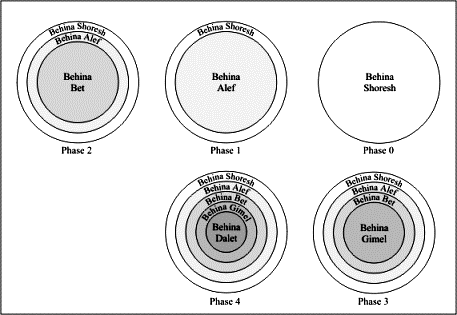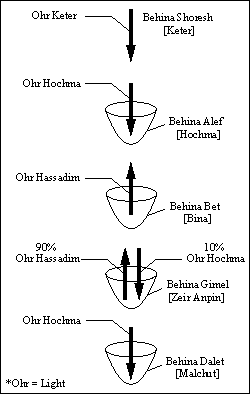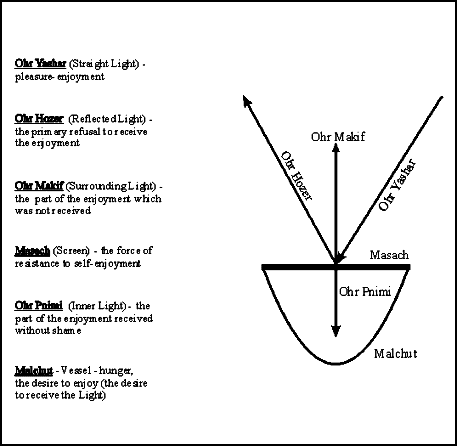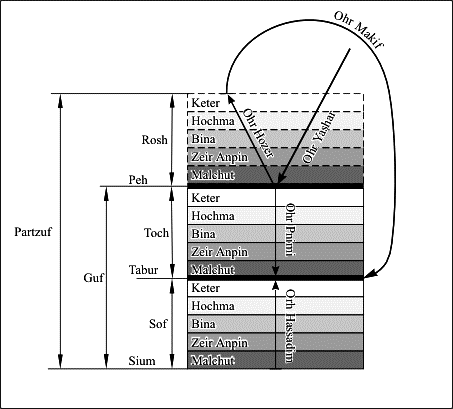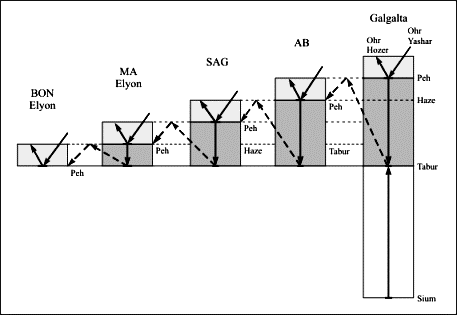Lesson 1
Topics examined in this lesson:
-
Three Sources: Rashbi, Ari, Baal HaSulam
-
The Four Phases
-
Giving for the Sake of Bestowing
-
The Guest and the Host
-
Equating to the Creator
-
The Freedom of Choice
-
The First Restriction
-
Roots of Creation
-
The Structure of Spiritual Configuration: Partzuf
-
Satisfying the Desire to Receive
Our knowledge of the spiritual worlds was given by people who managed to develop a perception of the upper worlds and described the mechanisms and structures of those worlds in their writings. Methods of establishing contact with these worlds were also passed on. This legacy enables us to enter the spiritual worlds, acquire the full knowledge, perceive complete perfection, understand the goal of Creation and fully grasp our existential purpose, while still living in this world.
This course by Rabbi Michael Laitman is based on three sources: Rabbi Shimon Bar Yochai’s Zohar written in the 2nd century CE, the works of the Ari, Rabbi Y. Luria, a Kabbalist who lived in Safed in the 16th century, and finally, the works of Rabbi Yehuda Ashlag (the Baal HaSulam), who lived in the middle of the 20th century.
These three Kabbalists are one and the same soul which reincarnated several times to teach an updated method leading to the mastery of the spiritual worlds, thereby easing the study of Kabbalah for the following generations.
This unique soul reached its highest level during its last incarnation, giving life to Rabbi Yehuda Ashlag, the Baal HaSulam. During its journey through our world this soul was able to provide explanations on the structure of the spiritual worlds beginning with the highest degrees, from the birth of the first being up to the completion of the correction of the universe.
Rabbi Yehuda Ashlag explains that the “Light emanating from the Creator” designates the desire to create beings and to please them. This phase is referred to as the Root Phase or Phase 0. In Hebrew, it is called Behina Shoresh or Keter, as shown in Figure 1.
Afterwards this Light creates a Vessel whose desire to receive pleasure perfectly matches it. The Light fills up the Vessel and pleases it. This is Phase 1, Behina Alef or Hochma.
The attribute of this Light is to give, to bear the delight, while the attribute of the Vessels consists in receiving, experiencing pleasure. However, when the Light enters the Vessel, it begins to transfer to the Vessel its attributes and the Vessel wishes to become like the Light; instead of wanting to receive, it now wants to give without restraint. At this stage, the Vessel desires to be like the Light, i.e. to give without restraint, and therefore it refuses to receive because it has nothing to give. This stage is called Phase 2, Behina Bet or Bina.
Being empty of the Light, the Vessel begins to consider that the goal of the Light consists in creating a Vessel and pleasing it. Clearly, the Vessel can only experience pleasure if it receives a certain portion of the Light.
The next phase corresponds to the desire to receive, let us say, ten percent of the Light, pleasure, but with an intention turned toward the Creator (bestowal). This process is in fact a mixed phase, Phase 3, Behina Gimel or Zeir Anpin.
After having reached this state, consisting of these two antagonistic elements, the “Vessel-Desire” realizes that it is more natural and better to receive than to give, to give without restraint. The original attribute of receiving and enjoying is rekindled. The Light of Hassadim, which has only filled ten percent of the Vessel, cannot transfer to the Vessel the attribute of giving without restraint, which thus leads to the predominance of the original attribute of receiving.
As a result, the Vessel decides that it must fill itself with one hundred percent pleasure, receive the entire Light. This is Phase 4, Behina Dalet or Malchut. Such a completely filled Vessel is defined as a true, genuine creation since its desires come from within itself, which is different from Phase 1, in that it had no independent desires of its own, being filled with the Light because the Creator so wished.
Only at Phase 4 the true choice to receive the Light emanating from the Creator is made by the created being itself. This first desire, to receive pleasure from the Light, is born inside the created being.
As shown in Figure 2, Hochma, Bina, Zeir Anpin and Malchut are the four phases of emanation of Light. The Light of Keter emanating from the Creator is meant to form the desire to receive, or the true creation.
There is nothing in the world except for the Creator’s desire to please and the created being’s desire to receive that pleasure. Everything is ruled by it. The entire creation in all its possible stages of development: inanimate, vegetative, animate and speaking - everything desires to receive a spark of the Light, to receive pleasure.
The Creator has brought forth the Creation so that upon receiving the Light it may experience infinite and everlasting pleasure, not in a selfish way, but rather in a perfect and an absolute way. If the Light enters the Vessel and fills it up completely, then this Vessel can no longer receive because the desire is saturated by the Light, and in the absence of a desire the pleasure passes away as well.
It is only possible to receive endlessly when you do not receive for your own sake, i.e. you enjoy for the sake of the giver. Then the Light entering the Vessel does not neutralize the desire to receive.
Through experience we all know that when we are hungry and begin to eat, after a certain time we no longer feel the hunger even if the most delicious dishes are made available.
Pleasure is experienced on the borderline between pleasure itself and the desire for it. However, as soon as pleasure enters the desire and starts to satisfy it, this desire slowly fades away. And if the pleasure is stronger than the desire this can even lead to repulsion.
How can pleasure be converted into something perfect and unbounded? A specific scheme has been devised by the Creator. If man feels pleasure not within himself, but while pleasing others, this pleasure is infinite because it depends solely on the amount of pleasure he can still give and to whom he is giving it. The more people I give it to the more pleasure do I feel myself. This condition produces an eternal existence, the perfection, which is one of the attributes of the Creator. This is exactly the state the Creator wants to usher us into.
If the created being wishes exclusively to receive, it finds itself trapped in a vicious circle. It can feel only whatever is inside of it. If the created being could feel the Creator’s pleasure from delighting the creation, it would endlessly experience the pleasure, just like a mother, who selflessly gives to her children.
The optimal scheme corresponds to perfection. The Light does not only transmit simple pleasure, but includes pleasure procured by unlimited knowledge, infinite existence, self-knowledge and self-analysis, a feeling of eternity and harmony, which pervades everything.
The ideal scheme includes the Creator relentlessly pouring the Light on the created being. The created being consents to receive the Light only if by doing so it pleases the Creator. This system is referred to as Returned Light or Reflected Light, as opposed to the Straight Light emanating from the Creator.
For this scheme to be, there must exist first and foremost a desire that attracts the Straight Light towards the created being. Secondly, the created being must place a Screen on the Light’s path. This Screen prevents the experiencing of pleasure for one’s own sake and enables the created being to receive pleasure, but only in proportion to what he can give for the sake of the Creator. Then the created being becomes completely like the Creator.
In other words, the following exchange takes place: the Creator procures pleasure to the created being who accepts it under the exclusive condition that by doing so it pleases the Creator.
The Baal HaSulam quotes the very simple and eternal example of the guest and the host. The host presents to his guest a table full of delicacies. The guest sits down but dares not eat because he does not want to be in a position to receive and he is not certain if the host is sincere in his desire to delight him. The guest is embarrassed because he has only to receive while the host gives. That is why the guest refuses what is offered in order to understand the host’s true desire.
If the host insists, asking his guest to honor the food and assuring him that he will be very pleased if he does so, then the guest will start eating. He will do so because he is convinced that this will please the host and he no longer feels that he is receiving from the host but giving to him, i.e., he gives him pleasure.
The roles have been reversed. Even if it is the host who has prepared all the food and acts as the inviter, he clearly understands that the fulfillment of his desire to please depends uniquely on his guest. The guest holds the key to the success of the dinner and consequently masters the situation.
The Creator has especially made the created being in such a way that under the influence of the Light it will feel ashamed of only receiving. The created being, using its freedom of choice freely, will reach a level where pleasure is not experienced selfishly, so as to please the Creator. In this case the created being equals the Creator; Malchut rises to the level of Keter and acquires divine attributes.
These divine attributes, these feelings are beyond description and we cannot conceive them. The entrance into the spiritual worlds by acquiring just one degree of similitude with the Creator already means eternity, absolute pleasure and attainment.
The science of Kabbalah studies the unfolding of Creation. It describes the path along which our world and all other worlds, the whole universe, must tread while achieving their progressive correction (Tikkun) to reach the level of the Creator, the ultimate degree of perfection and eternity. We need to undertake this work of correction while living in this world, in our everyday circumstances and dressed in our body.
Kabbalists have reached this degree of perfection and described it for us. All souls without exception must reach this ultimate level in due time. The reincarnation of souls in our world will carry on until the last soul has completed its way. It is only our world where the correction is possible in order to later on enter the spiritual world and eventually reach the zero-point, or Keter.
Could this process take place in one single life? No, that is impossible. When a person is born, he receives a soul that has already been in this world. This soul has experienced certain stages of correction and gained experience. That’s why the people born today are much smarter and have more experience than previous generations. They are more prepared to function under modern technological and cultural conditions, various transformations taking place in modern society. In our generation, the desire to study Kabbalah has become more and more popular. Souls have gained such a level of experience and reached such an understanding during past lives that a 20- to 25-year-old person cannot proceed without spiritual knowledge. In the past, on the other hand, only a handful amongst millions vaguely felt the need for spirituality.
In a few years only, it will be possible to reach spiritual attainment during one’s lifetime. This is the goal of creation; it has been predetermined. Each one of us is a fragment of the one and same Malchut (the original soul) and we are endowed with particular attributes and a specific part to play in this world. By transforming its attributes with the help of the scientific system of Kabbalah, each fragment performs its correction in order to reach its highest degree.
The fragment’s path is predefined from Above. We are all born in this world with a certain soul and specific qualities. None of us have chosen our soul in advance. It goes without saying that our path is also predetermined. So what are we to do? Where is our free will? In what way are we intelligent beings and not simply mechanical elements upon which such and such actions are carried out? To what extent did the Creator retreat to allow us to express ourselves? He did it by requiring one important condition: a man has to wish by himself to advance on the path of correction and elevation and may push himself in proportion to the strength with which he stimulates his own desires.
Each one of us has to start from the starting point and eventually reach the final point. There is no free will for this. There is also no free will for the path because everyone has to go through all its phases and feelings and progressively integrate them in himself. In other words, we must “live” the path.
Freedom means being in agreement with what happens all along the path, justifying each step and selecting the maximum speed to undergo the process of correction and bonding with the Creator. This is the only human-dependent factor and this is where the essence of creation lies. To wish by himself to most quickly get rid of the initial condition, the way the Creator created him, to undergo a correction of attributes, and in the final point to bond to the Creator.
Depending on how much man expresses this desire he may be called a man; otherwise he is a totally impersonal creature. Kabbalah is the only science that helps man to develop and be an independent, individual, truly free personality.
The four phases leading to the formation of a Kli (Vessel) can be differentiated by their desire to delight (Aviut, thickness or coarseness). In Phase 0 (Root Phase) and Phase 1 this desire is absent. The more remotely the created being stands from the Creator, the stronger the desire to delight, the coarser, the more selfish it is, the more it wants to receive.
The fourth phase, Malchut, is absolutely selfish, and this desire stems from its own decision. Each subsequent phase contains the previous one: Keter is in Hochma, both are then contained in Bina, the three are in Zeir Anpin. Malchut comprises the four previous phases. Every previous phase supports the next one and provides its existence.
The fourth phase has received all the Light, which filled it completely. We know that when the Light fills the Vessel with pleasure, the Vessel gradually receives from the Light its attribute to give. Malchut then begins to feel that its attribute is completely opposite to the attribute of the Light. It becomes aware of its selfishness compared to the giver, which breeds such a feeling of shame that it decides to stop receiving Light and remains empty.
The rejection of the Light from Malchut is called Tzimtzum Alef, the First Restriction. Once Malchut is empty, a state of equilibrium with the giver sets in; neither of them receives or gives, there is no reciprocal pleasure. So how can Malchut possibly equal the Creator?
By imitating the example of the guest and the host, Malchut pushes away all the incoming Light because it does not want to feel as the receiver. Then it sets the condition that it will accept a portion of the Light, though not for its own delight, but because it wants to please the Creator, as it knows that the Creator wishes its delight. Receiving in such a way is like giving, so Malchut is now in a position to be the giver.
We can see that the Light needs to undergo four phases if a true desire is to be brought to life. The same process takes place with all our desires whatever they are. Prior to the manifestation of a desire within us, this desire goes through all the phases of development of Light emanating from the Creator, until we finally feel it. No desire can emerge without Light. Light comes first, the desire afterwards.
Let us examine the structure of Creation created during Phase 4 (see Figure 3). The Light emanating from the Creator is called Straight Light (Ohr Yashar), the Light Malchut pushes away is called the Reflected Light (Ohr Hozer) and finally the Light entering partially into the Vessel is called Inner Light (Ohr Pnimi).
When the guest faces the host and the table full of delicacies he first refuses everything, then decides to eat a bit in order to please the host even though he would like to gulp everything down in one go. This means that one must use his selfish desires, but in an altruistic way. As the guest starts to consider things, he understands that he cannot accept the whole dinner for the sake of the host; he only may accept a small portion of it.
This is why the created being, after having performed a restriction, can accept with altruism a small portion of the Light, let’s say 20%, but it pushes away the remaining 80%. The part of the created being that makes a decision on how much Light it may accept inside for the sake of the Creator is called Rosh (Head). The part accepting the Light is called Toch (Inner part) and the last part, which remains empty, is called Sof (End). This is the place where the created being performs a restriction and no longer accepts the Light.
Different terms are attributed to the various parts of creation using analogies with the human body. There are no terms, labels and numbers in the spiritual worlds. It is nevertheless easier and more convenient to use words.
Kabbalists have chosen to express themselves in a very simple language: given the fact that everything in our world results from the spiritual worlds, in accordance with the direct connections descending from Above downward, from every spiritual object to every object in our world. Then for everything that has a name in our world, we may take the name of an object of our world and use it to designate the spiritual object that begets it.
Let’s take the example of a stone in our world. There is a force Above which generates this stone: it will therefore be named “stone.” The only difference is that the “spiritual stone” is a spiritual root endowed with specific attributes, which in turn matches a branch in our world, labeled “stone,” a material object. This is how the language of branches was created. By means of names, denominations and actions of our world we can refer back to elements and actions in the spiritual worlds.
None of the authentic Kabbalah scripts mention our world, not in a single word, although they may be using the language of our world. Every object of our world refers to a matching object in the spiritual worlds.
Hence the region of a spiritual object responsible for analysis and consideration is called Head (Rosh), see Figure 4. The part of the Screen located above Malchut and which lets the Light to enter inside is called Mouth (Peh). The part where the Light enters is called Body (Guf). The line exerting a restriction, inside the Guf , is called Navel (Tabur). The lowest part, which is devoid of Light, is called Conclusion (Sium). This object as a whole constitutes the Creation, the soul, Malchut.
Thus, after having received twenty percent of the Light in Toch, the region of Guf where the light is actually felt, the Partzuf begins to feel the pressure exerted from outside by the Surrounding Light, the Ohr Makif. It says: “You see how pleasant it is to accept a portion of the Light, you do not know how much pleasure remains outside, just try to accept some more.” We can understand that it is better not to experience pleasure at all than to experience just a tiny bit of it. Pleasure exerts pressure both from outside and inside and it therefore becomes much more difficult to oppose.
While it was not accepting any Light at all, the Partzuf could remain in that state for a long time, but now the Light exerts pressure both from inside and outside. If the Partzuf accepts some more Light, this means acting for its own delight, because the strength of its resistance to selfishness equals only twenty percent. The Partzuf declines to do so. It did perform the First Restriction, not to act later on in such a way. This would be totally inappropriate. There is only a single solution, which consists in rejecting the Light in order to revert to the initial state, the way it was before accepting the Light (see Figure 4). And this is exactly what the Partzuf does.
The pressure exerted simultaneously by the Ohr Pnimi and the Ohr Makif on the Tabur is termed “Bitush Pnim uMakif” (Blow from Inside and Outside).
How does the spreading of the Light (twenty percent in this case) inside the Guf take place? The Screen, which was initially positioned on the level of Peh de Rosh (the Mouth of the Head), is brought down by the Light’s pressure by twenty percent below the Peh into the Guf, until it reaches the line of the Tabur.
When the Light is expelled from the Guf, the Screen rises progressively from the Tabur to the Peh de Rosh, pushing the Light away. Before the spreading of the Light inside the Guf, the Partzuf had all information available in the Rosh. It knew what kind of Light it is, what kind of delight it brings, it knew what its own desire is, and how strong its force is opposed to the delight for its own sake.
According to all this information, as well as the information remaining from the state when the Partzuf was filled with Light, and from the state following the restriction of the Light, the Partzuf keeps a memory of the past - an imprint, which is called Reshimo.
What exists in the spiritual? Nothing but the desire to delight and the delights satisfying this desire. The information about the desire per se in the Partzuf is called Aviut, and the information corresponding to the Light, which would clothe itself with a Kli (Vessel), is called Hitlabshut. One can justly say that there is only the Creator and Creation.
From the previous state there always remain a Reshimo of Hitlabshut and a Reshimo of Aviut. These two parameters are sufficient to define the previous state of the Partzuf. After having rejected the Light, a Partzuf knows precisely what it felt when the Light resided in its Guf. With this experience it knows how to act and what sort of calculations it has to carry out.
The Partzuf, shown in Figure 5 below, understands that it is no longer possible to retain twenty percent of the Light. The decision is made to taste fifteen percent of it for the sake of the Creator.
For this to happen, the Partzuf needs to move down a bit so that its Rosh and Peh will be positioned below the level of the previous Partzuf. The Light hitting the Screen is pushed away, and only perhaps fifteen percent gets in.
How are the Hitlabshut and the Aviut determined? The calculation begins in the World of Ein Sof (the World of Infinity), where Malchut (Aviut Dalet, Desire of Level 4) is totally filled with the corresponding Light (Hitlabshut Dalet, Light of Level 4). This state of Malchut is shortly characterized by “Dalet-Dalet,” and is denoted by (4,4).
The next Partzuf retains the data that now it is capable to fill itself up with Light, which corresponds only to Aviut Gimel, Desire of Level 3, and so on.
Each of the following Partzufim lowers its capacity to fill its Guf with Light for the sake of the Creator more and more.
Altogether there are 25 Partzufim, which emerge from above to below. When the turn of the last Partzuf arrives, its lower part crosses the separating line, the Barrier (Machsom) between the spiritual world and our world, and begins to shine in our world. Our world is a state of Malchut characterized by the absence of a Screen.
